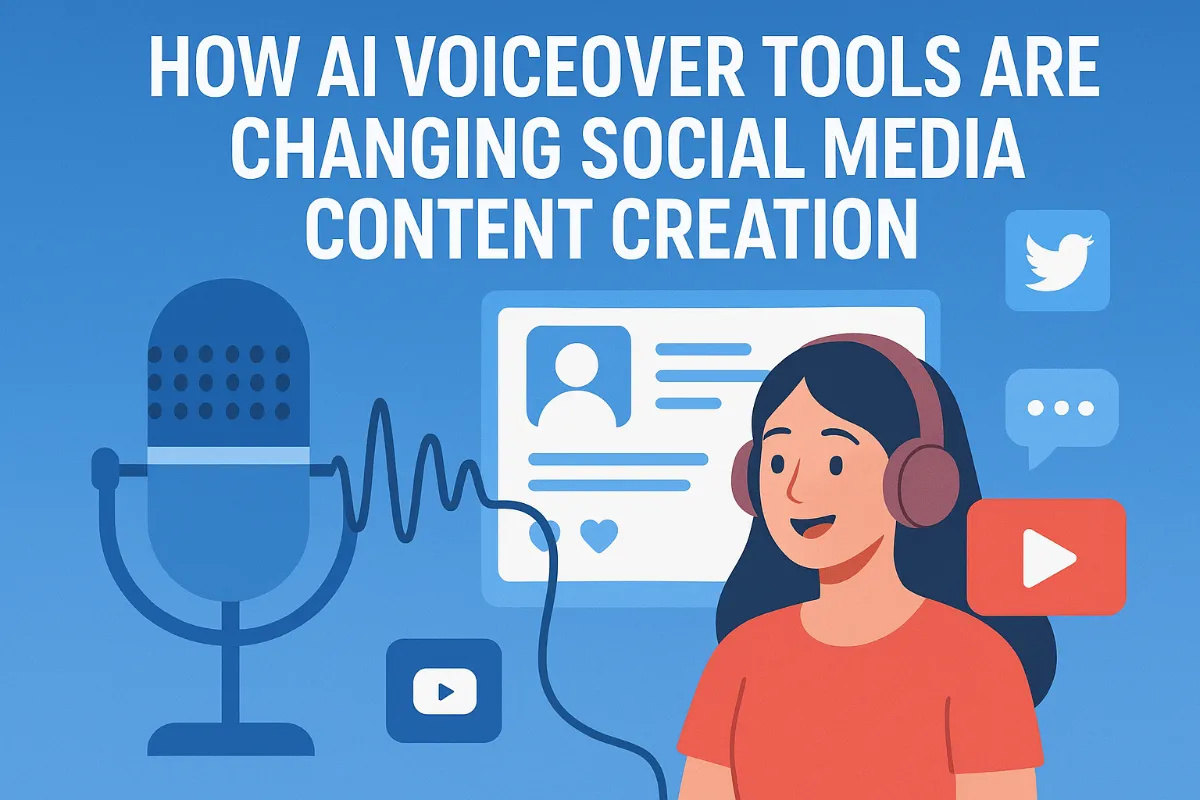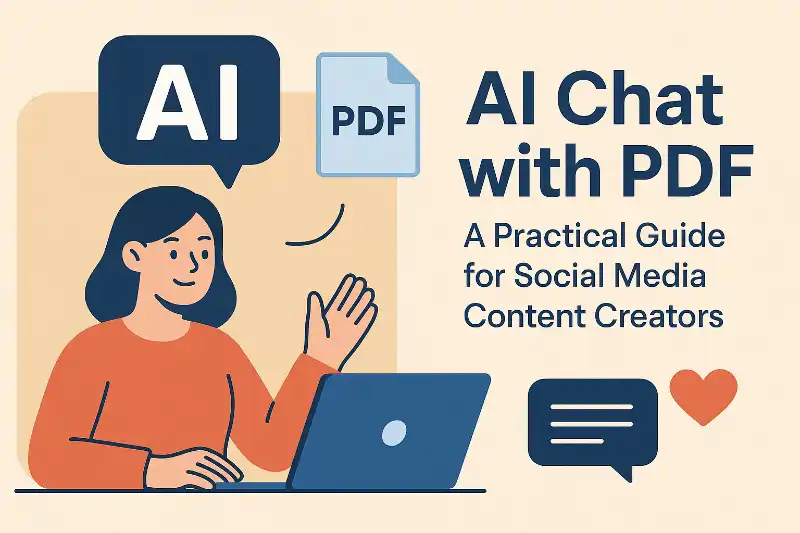AI for Social Media Accessibility: Making Content Inclusive
Understanding Social Media Accessibility
Did you know that social media reaches almost 60% of the world’s population? Social media accessibility ensures everyone can participate in online conversations, regardless of their abilities.
Social media accessibility means that people with disabilities can easily use social media platforms and content. It involves designing and presenting content in a way that is inclusive to individuals with visual, auditory, motor, or cognitive impairments. Social media accessibility is more than a business advantage; it's an ethical imperative and a commitment to digital inclusion.
- Defining social media accessibility and its importance: Accessibility ensures that everyone, including individuals with disabilities, can perceive, understand, navigate, and interact with social media content.
- Overview of disabilities that affect social media usage:
- Visual: Blindness or low vision can make it difficult to see images or videos.
- Auditory: Deafness or hearing loss impacts the ability to understand audio or video content.
- Motor: Conditions like arthritis or paralysis can affect the ability to type or use a mouse.
- Cognitive: Learning disabilities or ADHD can make it hard to process complex content.
- The business and ethical case for creating accessible social media content: Ethically, it ensures equal access to information and opportunities. Business-wise, it expands your audience, enhances brand reputation, and demonstrates social responsibility.
Despite its importance, social media accessibility faces several hurdles. Many content creators lack the awareness and training needed to create accessible content. Also, platforms often have limitations and inconsistencies in their accessibility features.
- Lack of awareness and training among content creators: Many social media users and marketers are unaware of accessibility guidelines, resulting in inaccessible content.
- Platform limitations and inconsistencies in accessibility features: While some platforms offer accessibility features, they may not be comprehensive or consistently implemented across all areas. For example, some platforms might have robust alt-text options but lack proper keyboard navigation support for certain interactive elements.
- The challenge of creating accessible content at scale: Producing accessible content can be time-consuming and resource-intensive, especially for organizations with large social media presences.
Accessibility isn't just a good practice; it's often a legal requirement. Neglecting accessibility can lead to legal ramifications and reputational damage.
- Overview of accessibility laws and guidelines: Laws like the Americans with Disabilities Act (ADA) and guidelines like the Web Content Accessibility Guidelines (WCAG) set standards for digital accessibility.
- The potential legal ramifications of neglecting accessibility: Businesses that fail to comply with accessibility laws may face lawsuits and fines.
- The ethical responsibility of creating inclusive online experiences: Creating accessible social media content aligns with the ethical principle of ensuring equal access and participation for all individuals.
Understanding these foundations sets the stage for exploring how artificial intelligence can revolutionize social media accessibility. The next section will explore how AI tools and technologies can help bridge the accessibility gap.
AI-Powered Tools for Accessible Content Creation
Did you know that AI can now generate alt-text for images, making your social media content instantly more accessible? Let's explore the world of AI-powered tools that are transforming content creation into an inclusive experience for everyone.
One of the most impactful uses of AI is in automated alt-text generation. AI algorithms analyze images and create descriptive text, assisting users with visual impairments. This process ensures that everyone can understand your visual content, regardless of their abilities.
Several tools and platforms now offer AI-powered alt-text generation. These tools use computer vision to identify objects, scenes, and contexts within an image. The AI then crafts a concise description that screen readers can convey to visually impaired users.
For example, an e-commerce platform could use AI to automatically generate alt-text for product images. A description like "A red, crew-neck t-shirt displayed on a white background" helps visually impaired customers understand the product details.
Remember to always review and refine AI-generated alt-text for accuracy and context. While AI can provide a solid starting point, human oversight ensures the description is comprehensive and relevant to your audience.
AI is revolutionizing video accessibility through AI-driven captioning and subtitling. These tools automatically generate accurate captions for videos, making content accessible to individuals who are deaf or hard of hearing. This technology also benefits those who prefer to watch videos with the sound off, which is common on social media platforms.
AI-powered captioning tools analyze audio and generate synchronized text. This is essentially a specific application of speech-to-text technology tailored for video. Some platforms even offer real-time captioning for live streams, ensuring live events are accessible to everyone.
For the best results, always review and edit AI-generated captions. Pay close attention to homophones (words that sound alike but have different meanings) and jargon specific to your industry. Accuracy and readability are key to a positive user experience.
Many organizations are now using AI to enhance social media accessibility. For example, healthcare providers use AI-generated captions on informational videos to reach a wider audience.
As AI continues to evolve, it promises even greater advancements in social media accessibility.
Enhancing Visual Content Accessibility with AI
AI can now analyze images to improve color contrast, ensuring that your social media posts are readable for everyone. Let's explore how AI enhances visual content accessibility.
AI can identify and describe key elements in images, making them accessible to visually impaired users. This technology significantly improves the social media experience for people with visual impairments.
AI algorithms analyze images and generate descriptive alt-text. These descriptions help screen readers convey the image's content to users with visual impairments.
For example, AI can identify objects, scenes, and contexts within an image. The AI then crafts a concise description that screen readers can use.
Image recognition technology uses computer vision to understand the content of an image. This allows AI to automatically generate alt-text, which is crucial for accessibility.
- AI analyzes the image and identifies key elements.
- It then creates a descriptive text that explains what the image is about.
- This text is used by screen readers to convey the image's content to visually impaired users.
Many tools now offer AI-powered image description. These tools can automatically generate alt-text for images, making content more accessible.
For instance, an e-commerce platform could use AI to automatically generate alt-text for product images. A description like "A person wearing a blue shirt and smiling" helps visually impaired customers understand the product.
AI tools can analyze color contrast to ensure readability, which is especially important for users with low vision. Sufficient color contrast makes text and other elements easier to see and understand.
Sufficient color contrast is vital for readability. AI can help social media platforms deliver more personalized content, which can also contribute to a better user experience by tailoring the presentation of information.
- Readability: Proper contrast ensures text is easy to read.
- User Experience: It improves the overall experience for users with low vision.
- Accessibility: It makes content accessible to a wider audience.
Choosing accessible color palettes involves selecting colors that provide sufficient contrast. AI tools can help analyze and recommend color combinations that meet accessibility standards.
You can use AI to test color combinations and ensure they meet accessibility guidelines. Remember to consider the needs of all users when selecting colors.
By using AI to enhance visual content accessibility, you can create a more inclusive social media experience. In the next section, we'll explore how AI can help with content moderation.
Improving Auditory Content Accessibility with AI
Is your social media content reaching everyone in your audience? AI can help you make auditory content more accessible, ensuring that individuals with hearing impairments can fully engage with your posts.
AI-powered speech-to-text services can automatically transcribe audio content into text. This technology allows you to provide transcripts for podcasts, audio clips, and other audio-based social media content. Transcripts make your content accessible to users who are deaf or hard of hearing, allowing them to read along or understand the audio's message.
- Providing transcripts for podcasts and audio clips ensures that your content is accessible to a wider audience.
- Transcripts also help users who prefer to read content or who are in environments where they cannot listen to audio.
- For example, a financial services company could provide transcripts of its market analysis podcasts, enabling investors with hearing impairments to stay informed.
Several tools and platforms offer accurate speech-to-text transcription. These tools often use machine learning to improve accuracy and can handle various accents and speaking styles. By using these services, you can easily generate transcripts for your audio content and make it more inclusive.
AI can also generate audio descriptions for visual elements in videos. This technology creates a narrative track that describes the visual content of a video, making it accessible to blind and visually impaired users. Audio descriptions enhance the viewing experience by providing context and details about what is happening on screen.
- Audio descriptions enhance accessibility for blind and visually impaired users by providing a clear understanding of the visual elements.
- This ensures that everyone can follow the storyline and appreciate the video's content.
- For example, a retail company could use AI to generate audio descriptions for its product demonstration videos, helping visually impaired customers understand the product's features.
AI-driven audio description tools analyze video content and automatically generate descriptive narratives. These tools use computer vision and natural language processing to identify key visual elements and create corresponding audio descriptions.
By implementing AI-powered speech-to-text transcription and audio description generation, you can significantly improve the accessibility of your auditory content. In the next section, we'll explore how AI can help with content moderation.
AI for Content Moderation and Inclusivity
AI is revolutionizing social media, but what about its role in keeping these platforms safe and inclusive? Let's explore how AI can help moderate content and promote diversity, creating a better experience for everyone.
AI plays a significant role in content moderation by identifying and removing harmful content. This includes hate speech, discriminatory language, and other forms of abusive material. AI algorithms can analyze vast amounts of text and images to flag content that violates community guidelines.
- AI systems can automatically detect patterns and keywords associated with hate speech, making it easier to remove offensive posts.
- AI algorithms can identify and filter out content that promotes discrimination based on race, gender, religion, or other protected characteristics.
- By removing harmful content, AI helps create a safer and more inclusive online environment for all users.
However, AI-powered content moderation is not without its challenges. AI algorithms can sometimes struggle with context and nuance, leading to false positives or negatives. For instance, an AI might flag a satirical post using a controversial term as hate speech (a false positive), or it might miss a subtly worded discriminatory comment (a false negative). Human oversight is crucial to ensure that content moderation decisions are fair and accurate.
AI can also be used to promote diverse representation in social media content. By analyzing content and identifying areas where diversity can be improved, AI tools can help creators make more inclusive choices.
- AI can analyze images and suggest diverse imagery that reflects a wider range of ethnicities, genders, and body types. Tools like Google Cloud Vision AI can identify demographic attributes in images, helping creators assess representation.
- AI tools can help identify and correct gendered language or other biased terms in text-based content. For example, sentiment analysis tools can detect biased phrasing.
- By promoting diverse representation, AI can help create social media content that resonates with a broader audience and fosters a sense of inclusion.
It's important to remember that AI is just a tool. Ultimately, it's up to content creators to make conscious choices about diversity and inclusion. AI can provide valuable insights and suggestions, but human judgment is essential to ensure that content is authentic and respectful.
Best Practices for Implementing AI Accessibility Tools
Effectively implementing AI accessibility tools can transform your social media presence, making it inclusive for everyone. But how do you ensure these tools are used to their full potential?
It's crucial to provide training to content creators on using AI accessibility tools effectively. This training should cover how to use AI-powered alt-text generators, captioning tools, and other accessibility features. By understanding the capabilities of these tools, creators can make informed decisions and optimize their content.
Educating teams about accessibility best practices and guidelines is equally important. This includes understanding WCAG standards, legal requirements like the ADA, and the ethical considerations of digital inclusion. A well-informed team can proactively address accessibility issues and create content that meets the needs of all users.
Fostering a culture of inclusivity within the organization is key to long-term success. This involves promoting awareness, providing resources, and recognizing the importance of accessibility in all aspects of social media content creation. A company culture that values inclusivity will naturally prioritize accessibility.
AI-generated content should be subject to human review and refinement. While AI can automate many tasks, it is not always perfect. Human oversight ensures that the content is accurate, contextually appropriate, and culturally sensitive.
This review is particularly critical for:
- Alt-text for images: AI might miss the nuance or context of an image, leading to inaccurate or unhelpful descriptions.
- Captions and transcripts: AI can struggle with accents, background noise, or specialized terminology, requiring human correction for clarity.
- Audio descriptions: Ensuring the emotional tone and essential visual cues are accurately conveyed requires human judgment.
Accuracy is paramount. AI algorithms can sometimes misinterpret images or generate inaccurate captions. A human reviewer can verify the accuracy of the AI-generated content and make any necessary corrections.
Ensuring context and cultural sensitivity is also critical. AI may not always understand the nuances of language or cultural references. Human reviewers can ensure that the content is appropriate for the target audience and avoids any unintended offense.
Establishing quality control processes for accessible content creation is essential. This includes developing checklists, providing feedback, and continuously improving the process. A well-defined quality control process will help ensure that all content meets accessibility standards.
Regularly evaluating the effectiveness of AI accessibility tools is essential for ongoing improvement. This involves tracking metrics such as engagement rates, user feedback, and accessibility compliance. By analyzing these metrics, you can identify areas where the tools are working well and areas where they need improvement.
Monitoring user feedback and making adjustments as needed is also important. User feedback provides valuable insights into the accessibility of your content. By listening to your audience and responding to their needs, you can continuously improve the user experience.
Staying up-to-date with the latest accessibility standards and technologies is crucial. Accessibility is an evolving field, and new standards and technologies are constantly emerging. By staying informed, you can ensure that your content remains accessible and compliant with the latest guidelines.
Implementing these best practices will help you harness the power of AI to create more inclusive and accessible social media content.
The Future of AI and Social Media Accessibility
The rise of AI in social media accessibility marks a significant shift towards inclusivity. What emerging trends will shape this landscape in the coming years?
- Future advancements include more sophisticated AI tools that can adapt to individual user needs, providing a truly personalized accessibility experience. Imagine AI that learns a user's specific preferences for caption speed or alt-text detail.
- AI has the potential to create more immersive social media experiences for everyone. For example, AI could generate real-time audio descriptions of virtual reality environments, making them accessible to visually impaired users.
- Personalized content, when tailored to individual accessibility needs, is one of the benefits of AI in social media.
The future of AI in social media accessibility hinges on teamwork.
- Collaboration between AI developers, social media platforms, and accessibility advocates is essential to ensure new technologies meet the needs of diverse users.
- By working together, these groups can create a more inclusive digital world, where social media is accessible to all.
- Users also play a role by providing feedback and insights, shaping the future of AI accessibility.
As AI continues to evolve, its impact on social media accessibility will only grow, fostering a more inclusive online environment.









